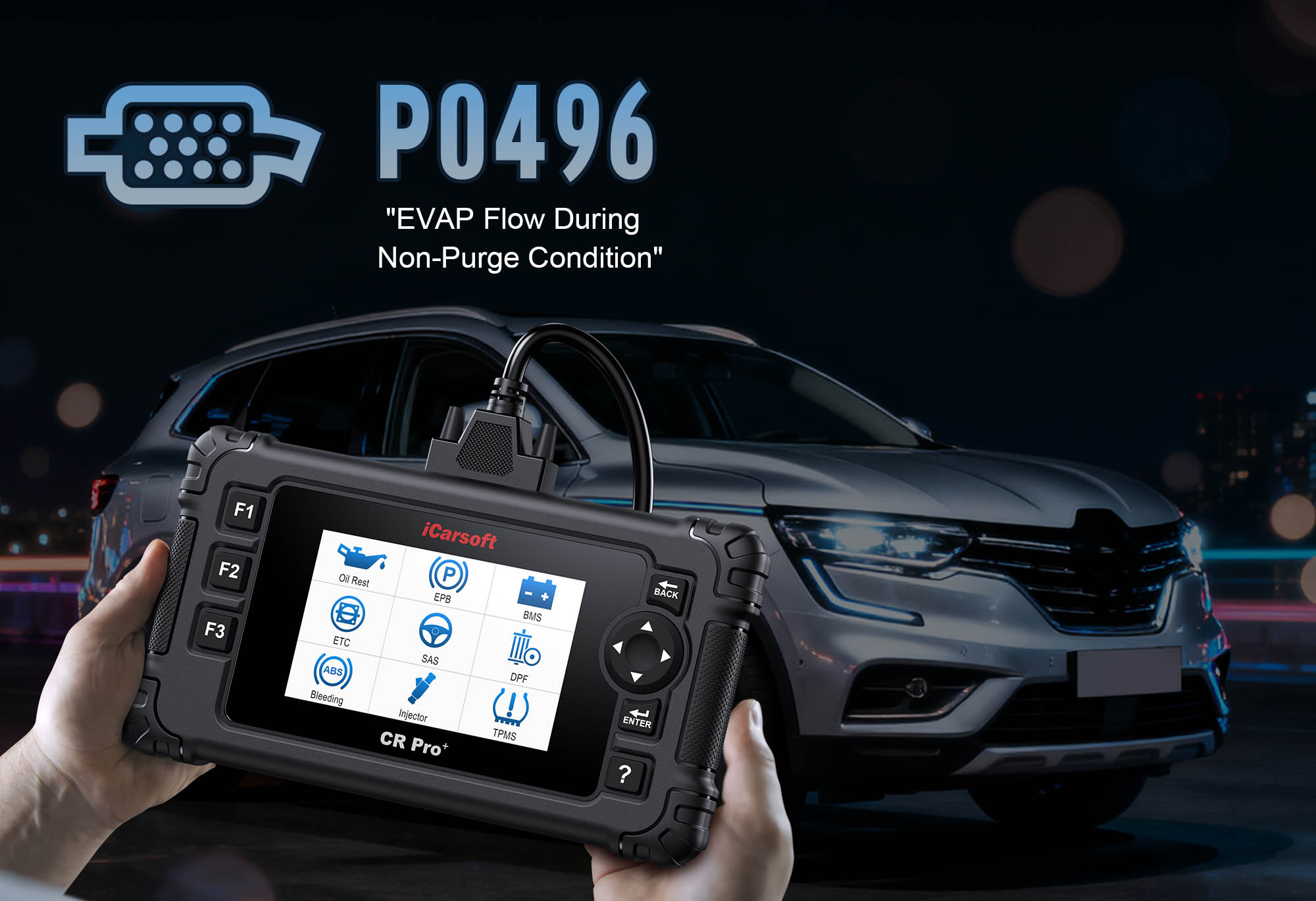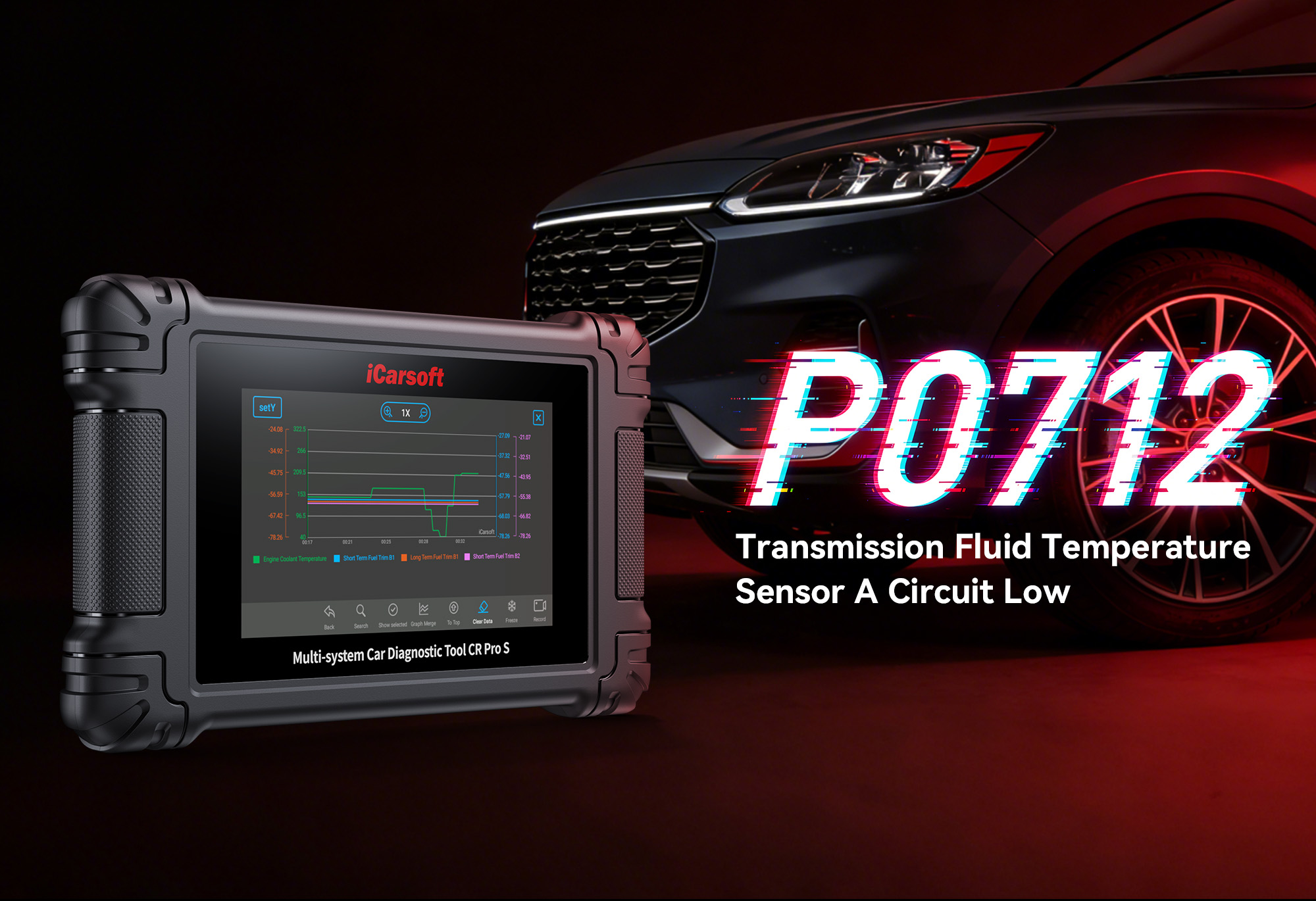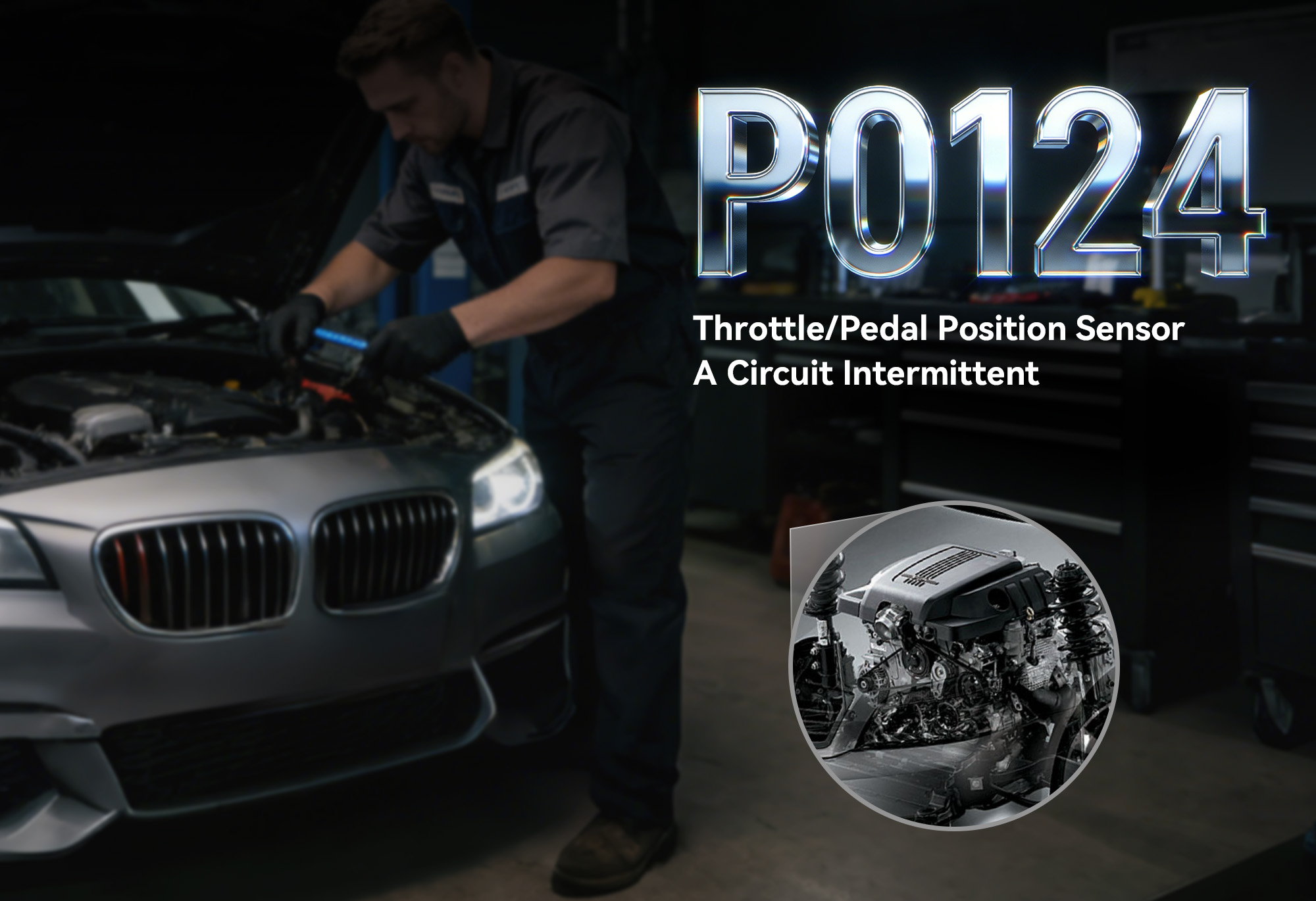Diagnose & Clear P0496 with iCarsoft CR Pro+: Fix EVAP Purge Flow Too High Issues
If your check engine light illuminates and a scan returns P0496, your vehicle’s Evaporative Emissions (EVAP) system is signaling a critical flow problem. This generic OBD-II code stands for "Evaporative Emission System Purge Flow Too High"—meaning the Engine Control Module (ECM) has detected that more fuel vapor than expected is being “purged” from the charcoal canister into the engine for combustion.
The EVAP system’s purge solenoid acts as a gatekeeper: it opens (under the ECM’s control) to send stored fuel vapors from the charcoal canister to the intake manifold, where they’re burned. When P0496 occurs, the purge solenoid either stays stuck open (allowing constant vapor flow) or malfunctions, causing excessive vapor to enter the engine. This disrupts the air-fuel mixture, leading to rough idle, reduced fuel efficiency, and failed emissions tests.
Basic scanners might only label P0496 as a "purge flow fault" but can’t test solenoid functionality or measure actual vapor flow. The iCarsoft CR Pro+—with its EVAP purge solenoid activation tests, flow rate monitoring, and system pressure tracking—solves this. Let’s walk through how to diagnose and resolve P0496.
 iCarsoft CR Pro+ monitoring EVAP purge flow rate to diagnose P0496
iCarsoft CR Pro+ monitoring EVAP purge flow rate to diagnose P0496
Understanding P0496: Causes & Key Symptoms
To tackle P0496 effectively, first map its impact on the EVAP system and vehicle performance:
Key Symptoms of P0496
-
Check Engine Light: Illuminates when the ECM detects purge flow exceeds manufacturer limits (e.g., >5 L/min when the solenoid should be closed) for 2+ drive cycles.
-
Rough Idle: Excessive fuel vapors disrupt the air-fuel mixture, causing the engine to vibrate or stall at stoplights.
-
Reduced Fuel Efficiency: Uncontrolled vapor flow leads to rich combustion—expect 5–10% higher fuel consumption.
-
Failed Emissions Tests: High hydrocarbon (HC) levels from unburned vapors cause test failures.
-
Engine Hesitation: Brief power drops during acceleration (excess vapors dilute the air-fuel mixture).
-
Fuel Odor (Rare): If the purge solenoid is stuck open, unfiltered vapors may escape, creating a faint gasoline smell near the engine bay.
Common Causes of P0496
|
Cause
|
Description
|
|
Stuck-Open EVAP Purge Solenoid
|
Debris, corrosion, or electrical failure prevents the solenoid from closing—constant vapor flow triggers P0496 (most common cause, ~40% of cases).
|
|
Faulty Purge Solenoid Wiring
|
Broken wires, corroded connectors, or short circuits keep the solenoid energized (open) unnecessarily—disrupts ECM control.
|
|
Clogged EVAP Purge Hose
|
A blocked hose between the solenoid and intake manifold creates backpressure—ECM misinterprets this as "too high flow."
|
|
Malfunctioning EVAP Pressure Sensor
|
Incorrect pressure readings (e.g., sensor thinks the canister is over-pressurized) cause the ECM to miscalculate purge flow—triggers false P0496.
|
|
Charcoal Canister Degradation
|
Broken internal components (e.g., charcoal pellets) block airflow—creates abnormal pressure/flow patterns that trigger the code.
|
|
ECM Software Glitch
|
Outdated firmware misinterprets flow data (common in 2012+ vehicles)—resolves with manufacturer software updates.
|
Why iCarsoft CR Pro+ Excels at Diagnosing P0496
The CR Pro+ outperforms basic tools with features tailored to EVAP purge system diagnostics—critical for pinpointing P0496’s root cause:
Bi-Directional Purge Solenoid Testing
Activates the solenoid (open/closed) directly from the scanner—listens for "clicks" and checks airflow to confirm if it responds to ECM commands (no wire disconnection needed).
Real-Time Purge Flow Monitoring
Measures actual vapor flow rate (in L/min) via the EVAP pressure sensor—compares to manufacturer limits (e.g., <1 L/min when solenoid is closed) to validate "too high" flow.
Circuit Voltage & Continuity Checks
Tests purge solenoid wiring for breaks, shorts, or low voltage (12–14V normal)—eliminates electrical issues as a root cause.
Vehicle-Specific EVAP Diagrams
Preloaded with purge solenoid locations, hose routes, and pressure sensor specs for 65+ makes (e.g., Chevrolet Silverado, Honda Civic, Volkswagen Jetta).
Purge Hose Blockage Detection
Uses pressure differentials to identify clogged hoses—no need to disconnect components; scanner alerts to backpressure issues.
ECM Firmware & Leak Test Tools
Scans for manufacturer software updates (fixes false codes) and runs post-repair leak tests to ensure the entire EVAP system is sealed (prevents P0442/P0455).
Step-by-Step: Diagnose P0496 with iCarsoft CR Pro+
-
1. Connect & Confirm the Code
1. Plug the CR Pro+ into your vehicle’s OBD-II port (under the dashboard) and power it on.
2. Select your vehicle via Auto VIN Scan (reads VIN in 2 seconds) or manual entry (make/model/year/engine—critical for EVAP system specifics).
3. Navigate to Engine > Fault Codes > Read Codes to confirm P0496. Tap Code Details for vehicle-specific insights (e.g., "Chevrolet: EVAP Purge Flow >6 L/min at Idle – Solenoid Stuck Open" or "Honda: Purge Flow Exceeds 3 L/min (Closed Solenoid)").
-
2. Check for Related EVAP Codes
P0496 rarely appears alone—scan for companion faults to narrow the root cause:
- P0440: General EVAP System Malfunction (systemic issue, e.g., canister degradation)
- P0442/P0455: EVAP Small/Large Leaks (caused by solenoid stuck open)
- P0452/P0453: EVAP Pressure Sensor Low/High Voltage (incorrect flow calculations)
- P0691: Purge Solenoid Control Circuit Low Voltage (wiring fault)
Multiple codes = address systemic issues (e.g., stuck solenoid + pressure sensor fault) instead of isolated hose problems.
-
3. Locate the EVAP Purge Solenoid
Pinpoint the solenoid to avoid testing the wrong component—use the CR Pro+’s guidance:
1. Navigate to Component Location > EVAP System > Purge Solenoid.
2. The scanner displays an engine bay diagram: the purge solenoid is typically mounted on the intake manifold, firewall, or near the charcoal canister (connected to two hoses: one to the canister, one to the intake).
3. Note the solenoid’s connector type (2-pin/3-pin) and mounting position—mark it with tape for easy access during testing.
-
4. Test Purge Solenoid Functionality (Bi-Directional Test)
The CR Pro+’s core tool for P0496—verifies if the solenoid opens/closes correctly:
1. Ensure the engine is off and the gas cap is tightly sealed.
2. Navigate to Special Functions > EVAP > Purge Solenoid Activation Test.
3. Follow on-screen prompts:
- Step 1 (Command Open): Scanner sends a 12V signal to energize the solenoid. Listen for a faint "click" (solenoid opening) and feel for gentle airflow through the solenoid hoses.
- Step 2 (Command Close): Stop the 12V signal. Listen for a second "click" and confirm airflow stops completely.
4. Interpret results:
- No click + no airflow change = faulty solenoid or wiring issue.
- Click but airflow continues when closed = stuck-open solenoid (replace immediately).
- Works correctly = clogged hose or pressure sensor fault.
-
5. Test the Purge Solenoid Circuit (Wiring & Voltage)
If the solenoid doesn’t respond, diagnose electrical faults:
1. Disconnect the purge solenoid’s electrical connector (wear gloves to avoid corrosion).
2. Navigate to Special Functions > EVAP > Purge Solenoid Circuit Test.
3. Connect the CR Pro+’s test leads to the connector terminals (follow scanner pinout diagram).
4. The scanner measures three critical values:
- Battery Voltage: 12–14V = normal; low = broken wire/loose connector.
- Ground Continuity: <1 ohm = good; high = corroded ground.
- Solenoid Resistance: 15–30 ohms (match manufacturer specs); infinite = faulty solenoid coil.
5. Fix issues: Splice broken wires with heat-shrink connectors; clean corroded terminals with a wire brush + dielectric grease.
-
6. Check for Purge Hose Blockage
A clogged hose creates backpressure that mimics "high flow"—resolve this low-cost issue:
1. Navigate to Special Functions > EVAP > Purge Hose Pressure Test.
2. The scanner commands the purge solenoid to open and monitors pressure in the hose between the solenoid and intake manifold.
3. Interpret results:
- High pressure (>5 kPa) = clogged hose (disconnect and blow compressed air through it to clear debris; replace if cracked).
- Normal pressure (<2 kPa) = no blockage—test the EVAP pressure sensor next.
-
7. Validate the EVAP Pressure Sensor
An incorrect sensor reading causes false P0496 triggers—verify accuracy:
1. Navigate to Engine > Live Data > EVAP System and select "EVAP System Pressure" and "Purge Flow Rate".
2. Start the engine and let it idle—monitor the data:
- Pressure should stay near atmospheric (0 kPa) when the solenoid is closed.
- Flow rate should be <1 L/min when closed (if >3 L/min, sensor is faulty).
3. If readings are abnormal: Replace the pressure sensor (use CR Pro+’s Part Lookup for OEM parts like Denso 550-0001 or Bosch 0281002934).
-
8. Update ECM Firmware (If Applicable)
Outdated software causes false P0496 codes in 2012+ vehicles:
1. Navigate to Special Functions > ECM > Firmware Check.
2. The CR Pro+ scans for manufacturer updates (requires stable Wi-Fi). Follow prompts to install—this resolves cases where the ECM misinterprets flow data.
3. After installation, clear existing codes and re-test the purge system.
-
9. Repair & Clear P0496
Fix the root cause based on diagnostics:
- Stuck-Open/Faulty Solenoid: Replace with OEM (check CR Pro+’s specs for compatibility, e.g., AC Delco 12610560 for GM).
- Wiring/Corrosion: Repair broken wires or clean terminals with dielectric grease.
- Clogged Hose: Clear with compressed air or replace if cracked.
- Faulty Pressure Sensor: Install a new OEM sensor.
- ECM Glitch: Complete firmware update.
Clear the code: Navigate to Engine > Fault Codes > Clear Codes to delete P0496 and related EVAP faults.
-
10. Verify the Repair
Confirm purge flow is normal to avoid reoccurrence:
1.Re-test the Solenoid:
Run the Purge Solenoid Activation Test—solenoid clicks and airflow stops when closed.
2.Monitor Live Data:
Idle flow rate <1 L/min (closed solenoid), <5 L/min (open solenoid)—matches manufacturer specs.
3.Test Drive:
Drive 30 minutes (include idle, city, and highway) to check for rough idle or hesitation.
4.Re-scan:
No P0496 return + improved fuel efficiency = successful repair.
5.Check Readiness:
Navigate to Readiness Monitors—ensure the EVAP monitor is "Ready" for emissions tests.
Preventing P0496 Recurrence
The CR Pro+ helps maintain a healthy EVAP purge system long-term, avoiding future P0496 codes:
-
Purge Solenoid Maintenance: Use the CR Pro+’s Service Reminder to test the solenoid every 15,000 miles—catch sticking early (before it triggers P0496).
-
Hose Inspections: Check purge hoses during oil changes for cracks, brittleness, or debris—replace if damaged (use fuel-resistant hose for replacements).
-
Sensor Checks: Validate the EVAP pressure sensor annually via live data—ensure readings are within normal range (0 ±2 kPa at idle).
-
ECM Updates: Check for firmware updates quarterly via One-Key Upgrade—resolves software glitches that cause false codes.
-
Fuel Quality: Use Top Tier gasoline to reduce carbon buildup in the solenoid (prevents sticking) and charcoal canister (avoids degradation).
-
Gas Cap Care: Tighten the gas cap until it clicks—loose caps cause pressure imbalances that strain the purge system.
Conclusion
P0496’s link to EVAP purge flow makes it a critical fault for engine performance and emissions compliance—but the iCarsoft CR Pro+ eliminates guesswork with purge-specific diagnostics. Unlike basic scanners that only label the code, the CR Pro+ lets you test the solenoid, measure flow rate, and verify repairs—ensuring you fix the root cause, not just the symptom.
Whether you’re replacing a $60 purge solenoid, clearing a clogged hose, or updating ECM firmware, the CR Pro+ guides every step—restoring smooth idle, fuel efficiency, and emissions readiness. With this guide, you’ll turn a "high purge flow" fault into a straightforward DIY repair—saving time and avoiding costly mechanic fees, all with professional-grade accuracy.
FAQs About P0496 Code
Q: Can I drive my vehicle with P0496?
A: Yes, but only short-term. P0496 doesn’t cause immediate engine damage, but it leads to rough idle, reduced fuel efficiency, and will fail emissions tests. If you notice severe hesitation or stalling, stop driving—this indicates a stuck-open solenoid flooding the engine with vapors.
Q: Why does P0496 return after replacing the purge solenoid?
A: Common reasons: 1) Unrepaired wiring (new solenoid still gets constant power), 2) Clogged purge hose (backpressure still tricks the ECM), 3) Faulty pressure sensor (incorrect flow calculations continue), 4) Non-OEM solenoid (incompatible with the ECM). Re-run the CR Pro+’s circuit and hose tests to identify the leftover issue.
Q: How much does it cost to fix P0496?
A: Costs vary by cause: Purge solenoid = $50–$150 (DIY); Wiring repair = $20–$50 (DIY); Pressure sensor = $80–$180 (DIY); Hose replacement = $10–$30 (DIY); ECM update = $0 (DIY via CR Pro+). Professional repairs add $100–$200 in labor—avoid this with the CR Pro+’s DIY diagnostics.
Q: Will cleaning the purge solenoid fix P0496?
A: Only if the solenoid is stuck due to light debris (e.g., dust). Use the CR Pro+’s Activation Test first—if the solenoid still doesn’t close after cleaning (with compressed air), replace it. Severe corrosion or electrical failure can’t be fixed with cleaning.

 iCarsoft CR Pro+ monitoring EVAP purge flow rate to diagnose P0496
iCarsoft CR Pro+ monitoring EVAP purge flow rate to diagnose P0496



